After Bernd Leno’s injury against Brighton in June, many Arsenal fans feared the worst. The German had been in excellent form all season and looked near unbeatable at times. His replacement, Emiliano Martínez, was a 27-year-old Argentinian in his 10th season at Arsenal. In his nine seasons prior, Martínez had made just six Premier League appearances, casting doubt over his goalkeeping ability.
Yet, a month on, and an FA Cup later, it is safe to say that Arsenal fans and Premier League viewers alike have been stunned by the level at which Martínez has performed. To many, it seemed as if nothing changed in-between the sticks, and now, Arteta is presented with a (happy) headache: who to pick when both are fit next season.
In this data analysis, I will examine the performances of Leno before his injury, and provide an analysis of the performances of Martínez since. I will compare these to the statistics of other Premier League goalkeepers to show the impressiveness of both men, and ultimately compare them to each other, in order to conclude who Arteta should choose as his goalkeeper for the 2020/21 season.
Player profiles
Bernd Leno signed for Arsenal from Bayer Leverkusen in the summer of 2018 for a fee of over £20 million. He enjoyed seven successful seasons for the German club, making over 300 appearances and keeping exactly 100 clean sheets. This was preceded by a long spell in VfB Stuttgart’s youth system, where he showed promising signs that he would develop into a solid goalkeeper. He has accrued six appearances for a German national team dominated by Bayern Munich’s Manuel Neuer and, despite a shaky first few months in North London, the 28-year-old has been impressive for Arsenal.
Emiliano Martínez was brought into the Arsenal setup in 2010 after he was signed from Independiente as a 17-year-old. It would be two years until he made his first team debut and a further two after that until his Premier League debut for the Gunners. The Argentinian seemed to be on the periphery wherever he played, with four underwhelming loan spells at Sheffield Wednesday, Rotherham, Wolves and Getafe. It was last season in the Championship with Reading that he was awarded consistent minutes: he made 18 appearances and kept five clean sheets for The Royals. He began Arsenal’s 2019/20 campaign as second-choice goalkeeper.
Leno before injury
While his safe handling makes him a difficult man to beat from distance, his quick reflexes ensure that attempts even from inside the box need to be special to get past the German. We can see below that he has only been beaten four times from outside of the box in all competitions this season.
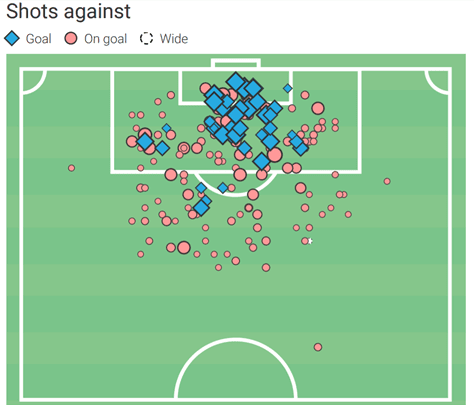
Despite only playing 30 games in the league this season, he has made 113 saves – the seventh most out of any goalkeeper (the six above him all played at least six more matches). It would be a mistake to read into this too much, as Arsenal’s defence is far from secure, but Leno has, out of all keepers to have played at least five league matches this season, the third highest save percentage, with 75.47
His average of 3.77 saves per 90 in the Premier League helped keep Arsenal’s opponents at bay many times, and also helped his team avoid embarrassment at times – he made nine saves in the 3-0 defeat to Man City on June 17. He has kept seven clean sheets and conceded a total of 39 goals against an xG of 47.37.
Another important quality of Leno’s is his confidence off of his line. He is not afraid to greet opposition attackers and has displayed his ability to sweep behind the defence too – he made the fourth-most recoveries of all Premier League keepers this season with 3.36 per 90.
It is important to Arteta that Leno is adept with his feet also. This season he averaged over 19 passes per 90. Notably, 88.28% of these reached their intended target, as did 98.7% of his passes under 20 metres. Below we can see the success of his goal kicks and a map displaying his passes in open play.
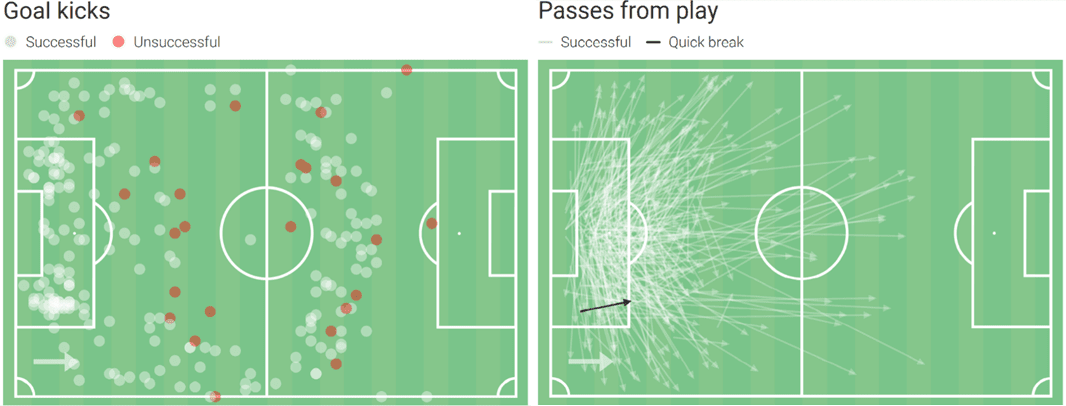
Martínez comes in
Despite the Argentinian’s inexperience at the top level, he has proved to be a more than capable replacement for Leno. Martínez has frequently displayed an impressive ability to get down low and stop shots – often holding them too, thereby preventing any follow-ups for opposition attackers. We can see his aptitude at saving low and in the corner in the diagram below (a circle represents a save, a larger circle represents a larger xG).
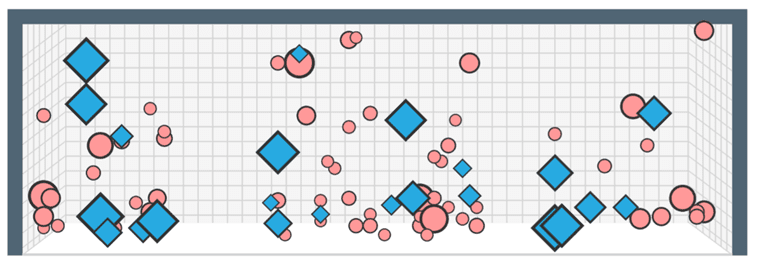
He averaged the eighth-most saves per 90 in the Premier League this season with 3.5, having only faced the 16th most shots per 90, with 4.45. His save success rate of 78.57% was only bettered by Tottenham’s Hugo Lloris.
When in-between the sticks, Martínez had an xG against of 11.23, yet he conceded only nine goals. This translates to an xG against per 90 of 1.19, and goals conceded per 90 of 0.95 – a difference of 0.24 per 90, which is almost a goal saved every four games! Martínez is also keen off his line, with 3.39 recoveries per 90 – the fourth-highest figure in the league this season.
Arteta will be more than satisfied with Martínez’s passing abilities. His goal kick and open play passes maps are shown below. Impressively, Martínez has a 100% success rate with short goal kicks, open play passes under 20 metres and all thrown passes. 90% of his open play passes between 20 and 40 metres are successful also, proving that he is more than capable of structuring attacks from the back.
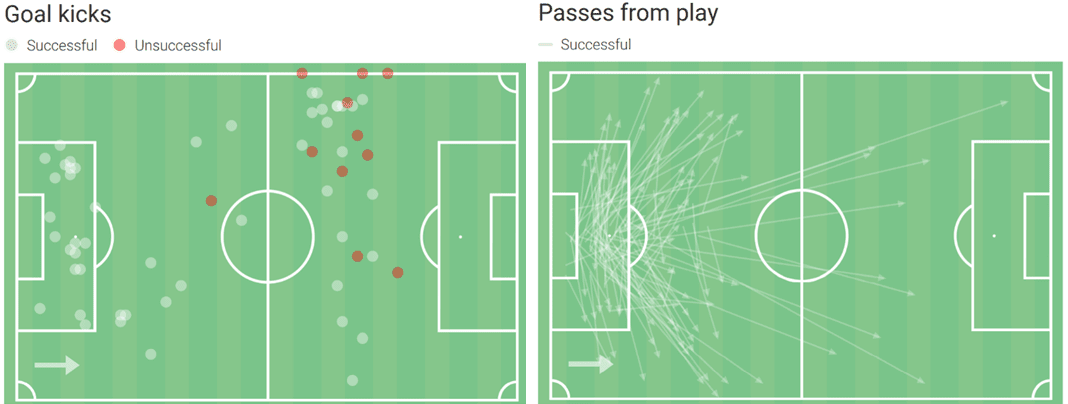
Comparison to other Premier League goalkeepers this season
Having listed the stats of the two men in isolation so far, it is now important to contextualise them with data from all Premier League goalkeepers. Below are diagrams depicting data of all goalkeepers to have played five or more games in the league this season.
Punches and Claims: Confidently claiming or clearing the ball can relieve a lot of defensive pressure and can also form the basis for counter-attacks. While a punch acts more as a clearance, it is a claim which will stop opposition attacks most effectively. As a defender, having a goalkeeper who can do this well will give you peace of mind.
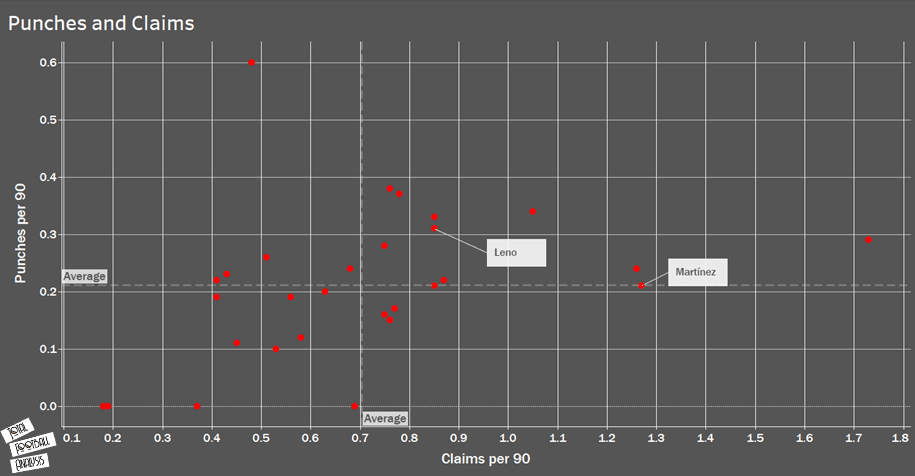
While Martínez is slightly below average in punches per 90 with 0.21, only one goalkeeper made more claims per 90 than him in the Premier League this season. His impressive figure of 1.27 is a display of the fearlessness that the Argentinian has been playing with since being called into the Arsenal side. It could also be suggested that his punches figure is only below average because he makes so many claims.
With 0.31 punches and 0.85 claims per 90, Leno is above average in both departments. While Leno does not stand out, these figures suggest a degree of confidence in leaving his line. Only five goalkeepers make more punches per 90 than Leno, but one would prefer him to make more claims and less punches.
Passes: It is desirable for a goalkeeper to be an accurate passer regardless of play style, but for Arteta, this is likely to be important. For goalkeepers, a high passing ability can benefit their teams in many ways. It is worth paying more attention to the pass accuracy metric, as passes attempted per 90 only give evidence for a preferred style of play, not passing ability.
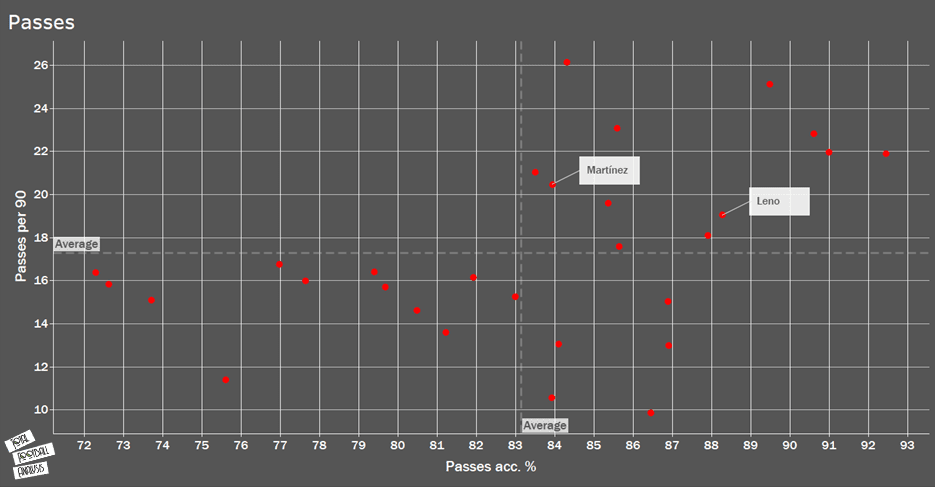
It comes as no surprise that both Leno and Martínez attempt an above-average number of passes per 90, with 19.04 and 20.46 respectively. More importantly, both men complete their passes with a higher degree of accuracy than the average. Martínez has a passing success rate of 83.94%, while Leno’s is 88.28%. This is a figure bettered only by four other goalkeepers.
It is clear that both men are good passers of the football. While Arsenal signed Leno with the knowledge of this skill, it is impressive that Martínez, having learned the ropes of the goalkeeping position in a different way to his German counterpart, has such an ability also. With both men above average in both departments, Arteta must be more than satisfied.
Shots faced and save percentage: Ultimately, you want your goalkeeper to make saves and prevent goals. When the defenders can’t thwart the opposition from taking a shot, it is down to the goalkeeper to stop it from going in the net. The diagram below maps the number of shots faced by goalkeepers per 90 and their save percentage. Anyone in the top right section has faced an above-average number of shots per 90 and has saved these shots an above-average number of times.
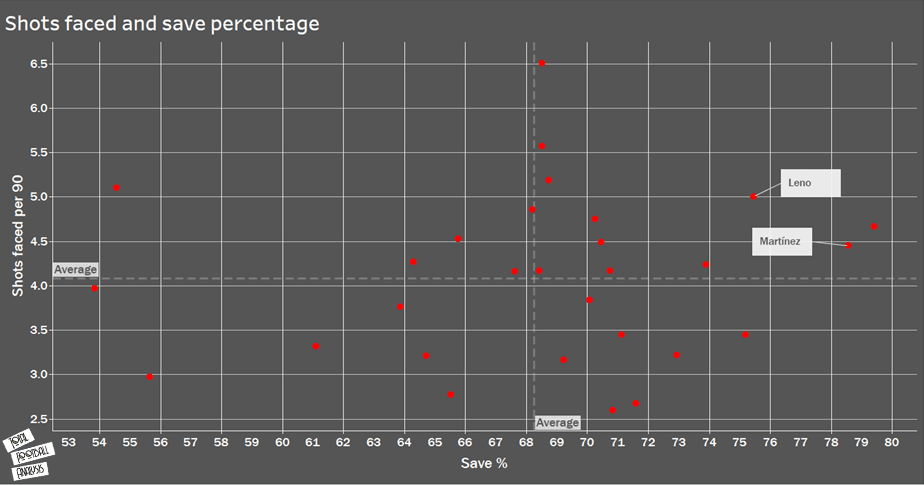
The fact that both Leno and Martínez have faced more than the average number of shots per 90 is no testament to Arsenal’s defence. Leno faced an average of 5 shots per 90 before his injury. Since coming in, Martínez faced an average of 4.45.
Their save percentages though are truly brilliant. With Leno’s save success rate of 75.47%, and Martínez’s 78.57%, the two of them have the second and third best save percentage figures in the league. Having two goalkeepers who save such a high percentage of shots they face is truly a blessing. Come the start of the season, Arteta will be aware that he has two incredible shot-stoppers to choose from.
Shots faced and goals conceded: While the results of this are largely generated from the above, it is still important to compare the two. A good combination of goalkeeper and defensive stability would place the keeper in the bottom-left section of the diagram – as they face a below-average number of shots and concede a below average number of goals. Those placed in the top-left section however face an above average number of shots yet still concede a below average number of goals. Here, defences may not be up to scratch, and a lot is owed to the goalkeepers.
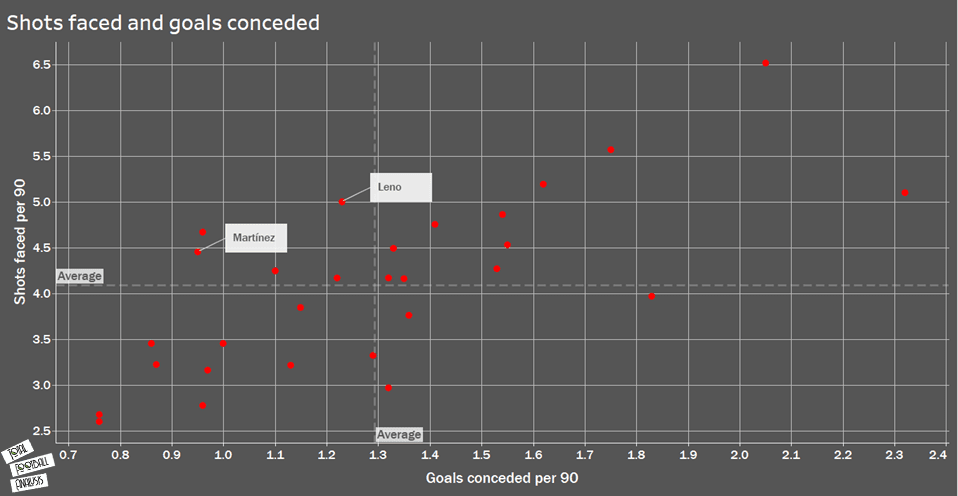
With both Leno and Martínez in this section, Arsenal can consider themselves lucky to have them. Their defence has been below par in many matches this season and, as already stated, this has led to Leno and Martínez facing more shots per 90 than the average goalkeeper.
Yet, both men are behind the average line of 1.293 goals conceded per 90; Leno conceded 1.23 per 90 this season, and Martínez conceded just 0.95 per 90. Arteta can consider himself exceptionally fortunate to have two goalkeepers who, in essence, can prevent goals to this extent. This will be shown most directly in our fifth and final diagram.
xG against and goals conceded: If I were to use just one metric to assess the effectiveness of a goalkeeper, it would be this one, as it essentially shows how many goals a goalkeeper has prevented (or allowed). Other factors like: saves, punches and claims will feed into the number of goals a keeper concedes, and comparing this to how many they are expected to have conceded can display just how good a goalkeeper is. At any point on the diagonal line, xG is equivalent to actual goals conceded. Anywhere above it, the goalkeeper has conceded less goals than expected. Anywhere below, the opposite.
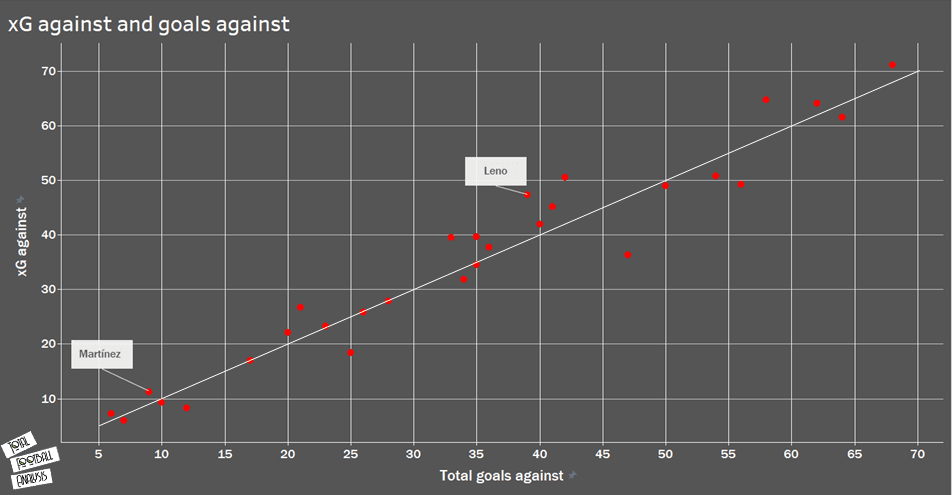
Unsurprisingly, both Leno and Martínez appear above the diagonal. Martínez conceded 9 goals against an xG of 11.23, and Leno conceded just 39 against an xG of 47.37. This means that, in the Premier League this season, Martínez conceded 19.9% less goals than expected, and Leno conceded 17.7% less goals than expected. This is hugely impressive. Having just one goalkeeper prevent this many goals is amazing, Mikel Arteta has two.
Statistically, we can see just how effective in-between the sticks both Leno and Martínez are. With Leno returning to full fitness, Arteta will have a selection headache (albeit a positive one) come the start of next season. With the Spaniard being spoilt for choice, who should he elect to play in goal for the 2020/21 season?
Final Comparison
While some important goalkeeping characteristics (such as vocal presence, or the confidence they give defenders) are immeasurable, statistics can display just how effective a goalkeeper truly is, as they prevent us from getting carried away by pure aesthetics.
There is little between the two goalkeepers (as depicted below): the percentage difference between their xG against and goals conceded is very similar, as are their save percentage figures. Leno may have conceded more per 90, but he faced more shots than Martínez per 90. The German also made more saves per 90, again showing that there is little to separate the two goalkeepers. In order to reach a conclusion, their differences must be drawn upon.

One notable difference is in their claims to punches ratios. In his nine league matches, Martínez made six claims per punch (the most in the league), whereas Leno made just 2.7. This implies that Martínez (with 1.91 actions per cross against) is more confident with his handling high up in the air than Leno (who has just 0.91 actions per cross against). In fact, in the past year, Leno has conceded from 75% of shots following a cross, whereas Martínez has done so just 33.3% of times. The Argentinian is also less likely to concede from direct free kicks and penalties, having let in just 33.3% of shots he faced of this kind, compared to Leno’s 40%.
Leno appears much more reliable when facing shots from outside the area due to his safe handling and good positioning. While he concedes from just 6.5% of shots outside the box, Martínez concedes from 10.7% of them. Yet, it is quite the opposite from shots on target in the box. Martínez’s reflexes and agility are deceiving for a man of his size, and he conceded from just 30.5% of shots on target in the box. Leno however conceded from 33.3% of shots of this kind. With shots on target occurring more frequently inside the box than out of it, it is desirable for a keeper to be more effective at saving from close range.
Though the two of them are very similar in terms of their statistics, at closer inspection, Martínez seems the favourite. The confidence that a keeper who claims and acts on crosses effectively can give a defence is invaluable, Martínez provides this. He is also a tidy passer, which will undoubtedly please his boss. He also appears slightly more reliable than Leno when facing all kinds of shots, aside from ones outside of the penalty area.
Conclusion
Having waited patiently for his chance in the Arsenal first team, Martínez grasped it with both hands. He has been aesthetically and statistically impressive and, while Leno is himself an exceptional goalkeeper, I see no reason why Arteta should not stick with Martínez for the coming season, especially after the Argentinian also played all six games in Arsenal’s victorious FA Cup run this season.
With little to split the two of them, Martínez’s adeptness at claiming the ball is something that works hugely in his favour. He also has proved more stable when facing shots from crosses, set pieces and from inside the penalty area. While shots from outside of the area seem to be his only weakness compared to Leno, he has shown incredible aptitude with his handling and reflexes and there is no doubt he can improve on this. Having been impeccable so far, Martínez should remain confident. As shown by this analysis, he could prove to be a vital part of an Arsenal team looking to rebuild under Mikel Arteta.

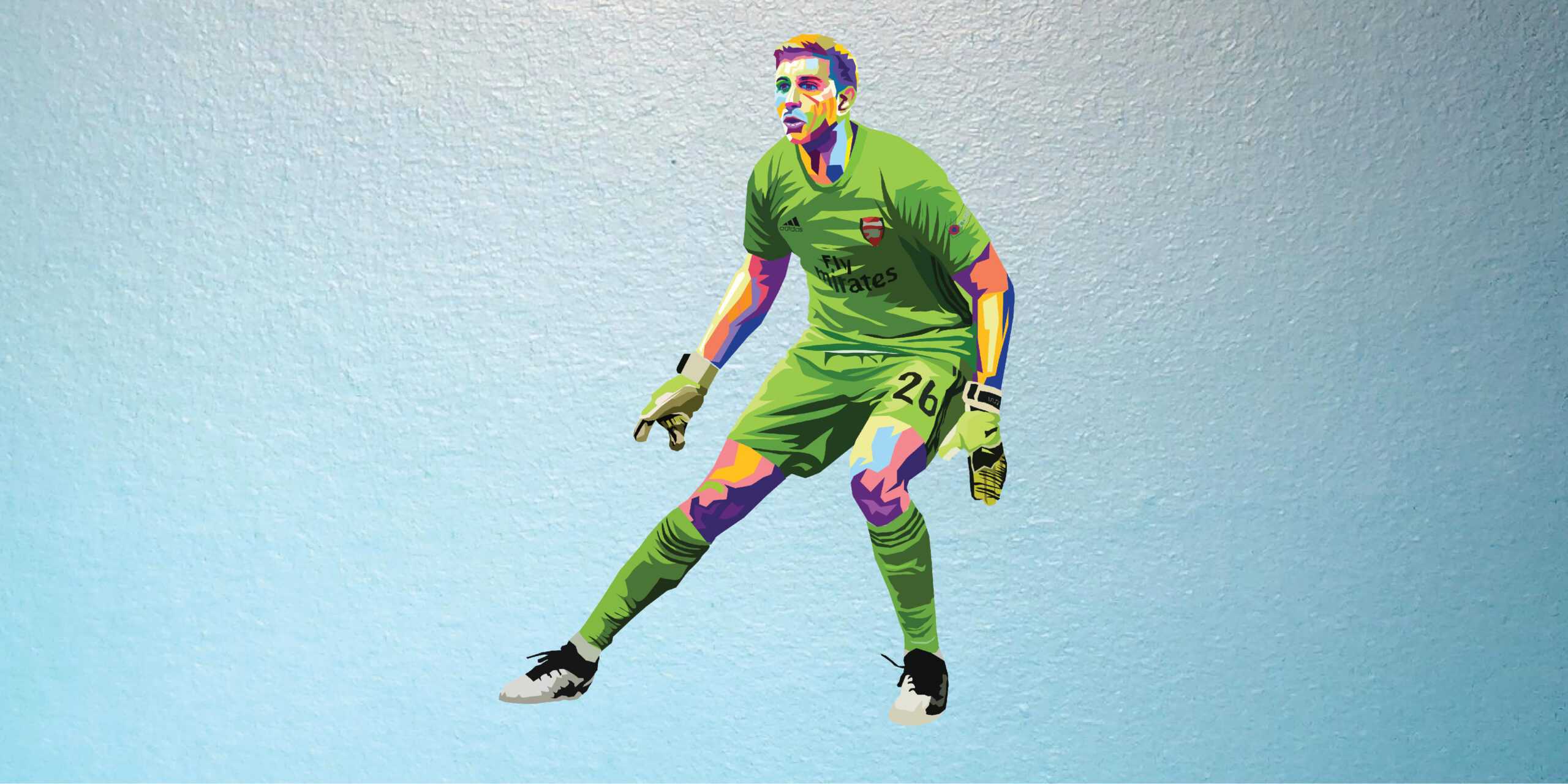



Comments